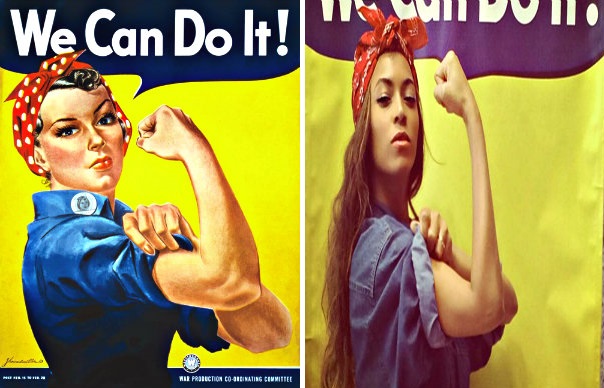When Beyonce posted a photo of her imitating the Rosie the Riveter look and posted that online, most news portals appropriated it as a shoutout of the singer’s feminist stand. But is Rosie the Riveter really the ultimate feminist icon?
Last July 22, 2014, entertainment portal E! Online posted an article with Beyonce’s take on the Rosie the Riveter look along with its famous one-liner banner “We can do it! “. The entry was entitled The Ultimate Feminist Photo.
However, The Guardian writer Rebecca Winson disagrees. In her write-up in the said news gateway the following day, she stated that Rosie the Riveter is, indeed, a cool image to emulate. Nevertheless, she is not a prime symbol of feminism.
The History Behind Rosie the Riveter
The image of Rosie the Riveter became popular in the US during the Second World War. She was the representation of the American women who came to work in the country’s various factories in the absence of the conscripted men who went off to war. Many of the female working force during those times were into munitions and war supplies making.
But the brain behind Rosie the Riveter, the bicep-curling woman in blue denim shirt with the red scarf tied on her head, was a man — J Howard Miller. Miller had his inspiration for his Rosie the Riveter from the weary and oil-covered factory workers. However, he dolled the picture up making it more attractive, appearance-wise. His Rosie the Riveter was washed and dolled up.
The image was, then , used to encourage women to get involved in the war by working in the factories. The idea behind the image was, working in the factories was a patriotic duty, a responsibility in the country’s war efforts.
The next years, Rosie the Riveter rose into fame. The icon became so popular other countries started to have their own Rosie the Riveter. The feminist movement also adopted her as a symbol. For years, until today, it is still used in feminist propaganda.
The Dent in the Picture
Miss Winson, on her part, stresses out the obvious. That Rosie the Riveter was not a brainchild of a female, but a male mind.
Besides, even if Rosie the Riveter became a successful banner in recruiting women to work “manly jobs” during WWII, they were given less pay than their male counterparts and were considered inferior to them. They were also expected to go back to their domestic lives or get sex-typed jobs like clerical posts after the war ended and the men who went off to fight came back. As a matter of fact, a number of women were discharged after the war. Their positions were given to the men who had them before WWII broke out.
These factors were, in reality, very un-feminist.
Is It or Is It Not?
But to redeem the image of Rosie the Riveter, the picture made a great contribution to WWII. Women giving significant inputs in the war are undeniable. Besides, Rosie the Riveter was the world’s eye-opener. It pushed the idea that women were not just for the homes; they can do “factory works”, too.
Because of the Rosie the Riveter campaign, the American female workforce increased from 12 million to 20 million.
Rosie the Riveter may not be the ultimate feminist icon, but it is one of America’s unforgettable cultural icons of the Second World War.
